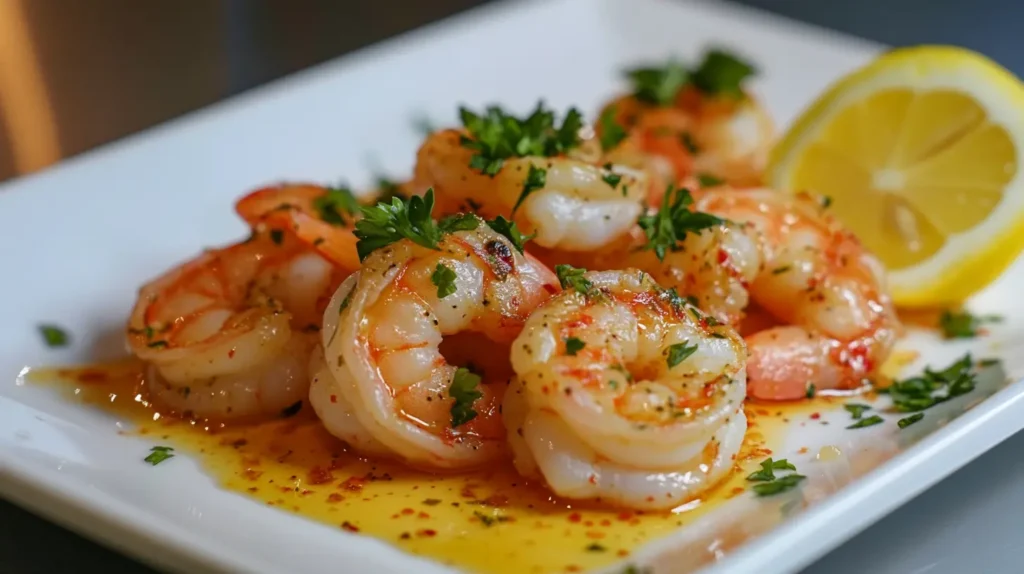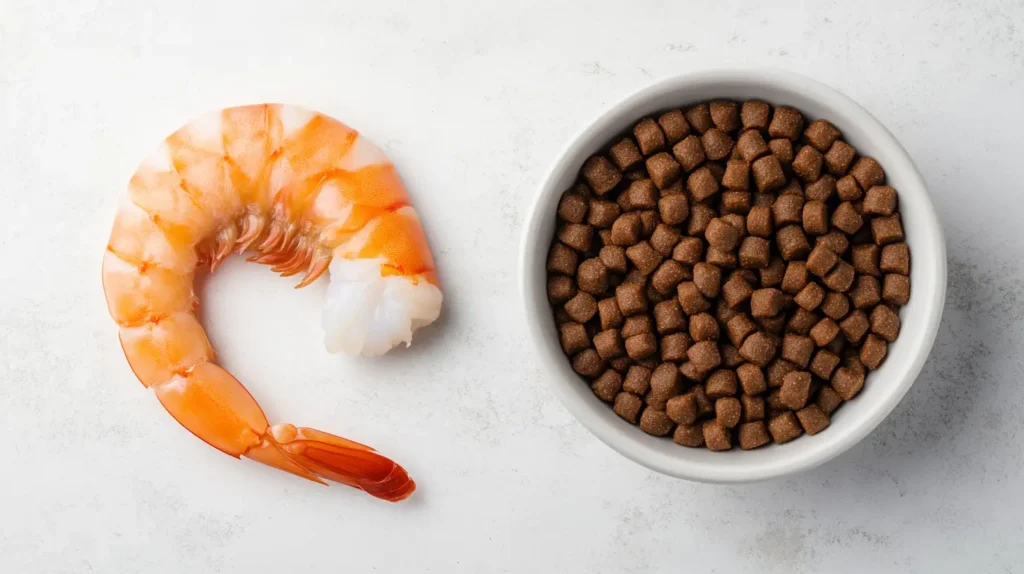Introduction
When it comes to sharing food with our dogs, we want to ensure everything we give them is safe and beneficial for their health. Shrimp is a widely loved seafood, packed with proteins and nutrients. Many dog owners incorporate shrimp into their pet’s diet as an occasional treat, but what about shrimp tails? These crunchy parts of the shrimp often end up discarded, but could they have a place in your dog’s bowl?
Understanding the dietary needs and restrictions of dogs is essential to keep them healthy and happy. While some human foods can be a nutritious treat, others might lead to digestive issues or more severe health problems.
In this article, we’ll explore whether shrimp tails are safe for dogs, weigh the risks and benefits, and provide guidance on preparing shrimp safely for your pup. Keep reading to find out everything you need to know about dogs and shrimp tails.
Table of contents
Nutritional Value of Shrimp

Nutritional Benefits of Shrimp for Dogs
Shrimp can be a fantastic addition to your dog’s diet—when prepared correctly. These little crustaceans are packed with nutrients that benefit both humans and dogs alike. But before we get into shrimp tails specifically, let’s look at the nutritional perks of shrimp itself.
High-Quality Protein Source
Protein is a crucial part of any dog’s diet, supporting muscle growth, energy levels, and overall health. Shrimp is an excellent source of lean protein, making it a great snack for dogs in small amounts. The high protein content can help keep your pup active and healthy.
Rich in Essential Vitamins
Shrimp contains several essential vitamins and minerals that are beneficial for dogs, such as:
- Vitamin B12: Supports a healthy nervous system and promotes red blood cell production.
- Niacin (Vitamin B3): Plays a vital role in maintaining energy levels and ensuring proper enzyme function.
- Zinc: Helps boost the immune system and promotes healthy skin and coat.
Omega-3 Fatty Acids
These healthy fats are well-known for their anti-inflammatory properties. For dogs, omega-3 fatty acids can:
- Support joint health, especially in older dogs.
- Promote a shiny, soft coat.
- Improve cognitive function.
Low in Calories and Fat
Shrimp is naturally low in calories and fat, making it a suitable treat for dogs that need to manage their weight. Unlike other meaty treats, shrimp doesn’t pack on unnecessary pounds when given sparingly.
Are There Any Downsides to Shrimp?
While shrimp is a nutritious snack, it’s essential to ensure it’s served plain and properly cooked. Avoid feeding your dog shrimp prepared with butter, garlic, onions, or other seasonings, as these can be harmful. Shrimp shells and tails, in particular, should be handled with caution due to potential hazards.
Understanding Shrimp Tails and Their Risks

Why Shrimp Tails Are Unsafe for Dogs
Shrimp tails might seem harmless, but their unique structure makes them unsuitable for your furry friend. While shrimp meat is soft and packed with nutrients, the tail is a different story.
- Tough and Indigestible
Shrimp tails are made of chitin, a natural material that forms the hard, protective shells of crustaceans. While chitin can be edible for some animals, it’s tough and not easily digestible for dogs. If your dog swallows a shrimp tail, their digestive system may struggle to break it down, leading to discomfort or blockages. - Sharp Edges
The rigid and pointed shape of shrimp tails can pose a physical danger. These sharp edges can:- Irritate your dog’s mouth or gums.
- Scratch or tear their throat as they swallow.
- Cause damage to the esophagus, stomach, or intestines if ingested.
- Lack of Nutritional Value
Shrimp tails don’t offer any nutritional benefits to dogs. While shrimp meat is full of protein, vitamins, and omega-3s, the tail doesn’t contribute positively to your pup’s diet.
Understanding these risks is vital to making informed decisions about what’s safe to share with your dog. Now, let’s explore the specific risks involved in feeding shrimp tails.
Risks of Feeding Shrimp Tails to Your Dog
Even a small shrimp tail can cause problems for dogs, depending on their size and how the tail is consumed. Here are the most common risks associated with shrimp tails:
- Choking Hazards
Shrimp tails are small enough to become lodged in your dog’s throat, especially for smaller breeds. This can lead to choking, causing your dog to gag, cough, or even struggle to breathe. - Gastrointestinal Blockages
If swallowed, shrimp tails can travel to the stomach or intestines, where they may cause a blockage. Symptoms of a blockage include:- Vomiting or nausea.
- Constipation or difficulty passing stool.
- Abdominal pain or swelling.
A gastrointestinal blockage is a serious condition that often requires veterinary intervention, sometimes even surgery.
- Internal Injuries
The sharp, jagged edges of shrimp tails can injure your dog’s internal organs. These injuries can result in:- Bleeding or tearing in the digestive tract.
- Pain and discomfort.
- Risk of infections if the stomach lining is punctured.
- Allergic Reactions
While the meat of shrimp is more commonly associated with allergic reactions, shrimp tails can still trigger a reaction in sensitive dogs. Watch for signs such as:- Excessive itching or swelling.
- Vomiting or diarrhea.
- Difficulty breathing.
- Bacterial Contamination
If shrimp tails aren’t fresh or cooked properly, they can carry harmful bacteria like Salmonella or Listeria. This poses an additional health risk, potentially causing foodborne illness in your dog.
Why Avoiding Shrimp Tails Is the Best Choice
Ultimately, shrimp tails offer no benefits and carry numerous risks. While some dogs might swallow them without issue, the potential for choking, blockages, or injuries outweighs any chance of safely eating them. Opting for cooked, de-tailed shrimp or safer alternatives ensures your dog can enjoy a treat without compromising their health.ithout the associated risks.
Risks of Feeding Shrimp Tails to Your Dog
While shrimp tails may not seem like a big deal, they can pose several risks to your dog’s health. From choking hazards to potential digestive issues, it’s essential to understand why these crunchy leftovers aren’t the best snack for your furry friend.
1. Choking Hazard
One of the most significant dangers of shrimp tails is their potential to cause choking. Dogs don’t always chew their food thoroughly, especially when it’s something as small and irregularly shaped as a shrimp tail.
- Small and Medium Breeds: Smaller dogs are particularly vulnerable to choking because their airways are more compact.
- Excited Eaters: Dogs that gulp down food without chewing properly are at higher risk.
Choking is a serious situation that may require immediate veterinary assistance, so it’s best to avoid giving shrimp tails altogether.
2. Digestive Blockages
Even if your dog manages to swallow a shrimp tail, its tough texture can lead to blockages in the digestive system. Shrimp tails aren’t easily broken down by stomach acid, meaning they can linger in your dog’s intestines and cause problems like:
- Vomiting
- Loss of Appetite
- Abdominal Pain
- Constipation or Difficulty Passing Stool
In severe cases, a blockage may require surgical intervention to remove the shrimp tail and restore your dog’s digestive health.
3. Sharp Edges and Internal Injuries
The rigid, pointy structure of shrimp tails makes them a hazard for your dog’s delicate digestive tract. Swallowing sharp-edged items can lead to:
- Mouth or Throat Irritation: The edges may scratch your dog’s mouth, tongue, or throat, causing discomfort or small cuts.
- Esophageal Tears: If a shrimp tail gets stuck on the way down, it could scrape or tear the esophagus.
- Internal Damage: Once inside the stomach or intestines, the sharp pieces can irritate or puncture the lining, leading to internal bleeding or infections.
4. Allergic Reactions
Although not common, some dogs can have allergic reactions to shrimp. This can occur with any part of the shrimp, including the tails. Symptoms of an allergic reaction in dogs include:
- Itching or Swelling
- Hives or Red Skin
- Vomiting or Diarrhea
- Difficulty Breathing
If your dog shows any signs of an allergic reaction after consuming shrimp or shrimp tails, contact your veterinarian immediately.
5. Bacterial Contamination
If shrimp tails aren’t properly cooked or stored, they could harbor harmful bacteria like Salmonella or Listeria. Dogs who consume contaminated food may experience:
- Diarrhea
- Fever
- Lethargy
- Abdominal Cramps
Cooking shrimp thoroughly can reduce this risk, but the hard structure of the tails still makes them an unnecessary danger.
Is It Ever Okay to Feed Shrimp Tails to Dogs?
Given the potential risks, it’s generally best to avoid feeding shrimp tails to dogs. While some dogs might manage to chew and digest them without any issues, the hazards far outweigh the potential benefits.
Safe Ways to Prepare Shrimp for Dogs
While shrimp tails are not the best snack for your dog, shrimp itself can be a healthy and enjoyable treat when prepared correctly. Dogs can benefit from the protein and nutrients in shrimp, but preparation is key to ensuring their safety. Let’s walk through the safest ways to serve shrimp to your furry friend.
1. Cook Shrimp Thoroughly
Raw shrimp can carry harmful bacteria like Salmonella and Listeria, which can lead to foodborne illnesses in both dogs and humans. Always cook shrimp thoroughly before serving it to your pup.
- Boiled or Steamed: These are the healthiest cooking methods, as they preserve nutrients without adding any harmful ingredients.
- Avoid Frying: Fried shrimp may contain excessive oil, fat, and batter, which aren’t good for dogs.
2. Remove the Shell and Tail
Before serving shrimp to your dog, it’s important to completely remove the shell and tail. Here’s why:
- Digestibility: The shell and tail are hard for dogs to digest and may cause gastrointestinal issues.
- Safety: Removing these parts eliminates the risk of choking or internal injuries from sharp edges.
Only serve the soft, cooked meat of the shrimp to ensure your dog can eat it comfortably.
3. Avoid Seasonings
While we humans love shrimp seasoned with garlic, butter, salt, or spices, these can be harmful to dogs. Ingredients like garlic and onion are toxic to dogs, and excessive salt can cause dehydration or sodium poisoning.
- Plain is Best: Serve shrimp plain, without any added seasonings, oils, or marinades.
- Watch for Hidden Ingredients: If you’re using pre-cooked shrimp, check the label to ensure no harmful ingredients were added during processing.
4. Portion Control
Shrimp should be considered an occasional treat rather than a regular part of your dog’s diet. Too much shrimp can lead to digestive upset or an imbalance in their diet.
- Small Amounts: A few small pieces of shrimp meat are enough to satisfy your dog’s craving without overloading their system.
- Frequency: Limit shrimp treats to once or twice a week, depending on your dog’s size and dietary needs.
5. Monitor Your Dog’s Reaction
Whenever you introduce a new food to your dog, keep an eye out for any adverse reactions. This is especially important with shrimp, as some dogs may have seafood allergies or sensitivities.
- Start Small: Offer a tiny piece of shrimp and observe your dog for any signs of discomfort, like vomiting, diarrhea, or itching.
- Consult Your Vet: If you’re unsure whether shrimp is right for your dog, talk to your veterinarian before including it in their diet.
Bonus Tip: DIY Shrimp Treat Recipe for Dogs
If you’d like to create a special shrimp treat for your pup, here’s a simple recipe:
Ingredients:
- Fresh, deveined shrimp (tails and shells removed)
- A small amount of plain pumpkin puree (optional)
Instructions:
- Steam the shrimp until fully cooked.
- Let the shrimp cool completely.
- Mash the shrimp with a small amount of plain pumpkin puree for added fiber and flavor.
- Roll into small, bite-sized balls and serve.
Your dog will love this nutritious, homemade snack!
What About Other Seafood for Dogs?
If you’re looking for alternatives to shrimp tails, consider these dog-safe seafood options:
- Salmon: Rich in omega-3 fatty acids, but always cook thoroughly and remove bones.
- Tuna: Safe in small amounts as an occasional treat, but avoid canned tuna with added salt.
- Whitefish: A mild and lean fish that’s easy on your dog’s stomach.
These alternatives provide similar nutritional benefits without the risks associated with shrimp tails.
Now that we’ve covered safe ways to prepare shrimp for your dog, let’s look at some healthier alternatives to shrimp tails that your pup will enjoy.
Alternatives to Shrimp Tails for Dogs
If your dog loves seafood or crunchy snacks, there are plenty of alternatives to shrimp tails that are safer and just as enjoyable. These options allow you to provide a tasty treat while avoiding the risks associated with shrimp tails. Let’s explore some of the best substitutes for your furry friend.
1. Cooked Shrimp Meat (Tail-Free)
As mentioned earlier, shrimp meat itself can be a nutritious and delicious treat for dogs. Remove the shell and tail, cook it thoroughly, and serve it plain. It’s a simple way to share seafood with your pup without worrying about hazards.
2. Fish Skin Treats
Dehydrated fish skin treats are a favorite among dogs. They’re crunchy, tasty, and packed with omega-3 fatty acids that support a shiny coat and healthy joints.
- Why They’re Great: Fish skin is soft enough to chew and digest, but still provides a satisfying crunch.
- Available Options: Look for pre-made dog treats made from salmon or cod skin at pet stores.
3. Dehydrated Sweet Potato Chews
For a crunchy, seafood-free alternative, try dehydrated sweet potato chews. These treats are rich in fiber and vitamins, making them a healthy option for your dog’s diet.
- Benefits: Sweet potatoes are gentle on the stomach and can help regulate digestion.
- DIY Option: Slice a sweet potato into thin strips and bake or dehydrate until crispy.
4. Carrot Sticks
Raw carrots are a low-calorie, crunchy treat that dogs love. They’re full of vitamins and minerals, and they double as a natural toothbrush, helping to clean your dog’s teeth as they chew.
- Why Dogs Love Them: Carrots are sweet, crunchy, and safe to eat raw or cooked.
- Pro Tip: Freeze carrot sticks for a refreshing summer snack.
5. Freeze-Dried Seafood Treats
For a seafood alternative without the risks, try freeze-dried fish or shrimp treats made specifically for dogs. These products are processed to remove harmful bacteria and are tailored to your dog’s dietary needs.
- Available Options: Look for single-ingredient treats at pet stores to ensure quality and safety.
- Benefits: These treats retain all the flavor and nutrients of seafood without the risks associated with tails or shells.
Why Choose Safer Alternatives?
Choosing safe alternatives to shrimp tails not only prevents potential health issues but also ensures your dog enjoys their treats without discomfort. Dogs love variety, and offering them new, safe options keeps them excited about snack time.
How to Choose the Right Treat for Your Dog
Every dog has unique preferences and dietary needs, so consider the following when choosing a treat:
- Size and Texture: Make sure the treat is easy for your dog to chew and swallow.
- Nutritional Content: Opt for treats that provide added health benefits, like vitamins, minerals, or fiber.
- Allergy Concerns: Avoid ingredients your dog is allergic to, and introduce new treats gradually to check for reactions.
Wrap-Up: Healthy and Safe Treats for Your Dog
While shrimp tails might seem harmless at first, their risks make them a less-than-ideal choice for your dog. Luckily, there are many safer and healthier options available. Whether it’s cooked shrimp meat, crunchy vegetables, or freeze-dried fish, you can still give your dog a treat they’ll love without compromising their health.
With proper preparation and mindful choices, you can keep your furry friend happy, healthy, and well-fed. Next time you’re enjoying seafood, you’ll know exactly how to share the love safely!
Conclusion
To wrap things up, shrimp can be a delicious and healthy snack for your dog when served properly, but shrimp tails are a no-go. Their tough texture can be a choking hazard or cause internal injuries, so it’s best to stick to plain, cooked shrimp without any seasoning. Your furry friend will thank you for the safer treat!
If you want to make sure you’re handling shrimp correctly, check out How Long Can Cooked Shrimp Stay in the Fridge for storage tips. Curious about shrimp’s nutritional benefits? Learn more in What Do Shrimp Eat?. And if you’re looking for cooking inspiration, don’t miss Is It Best to Cook Shrimp in Butter or Oil? and the tasty BBQ Shrimp Recipe for ideas.
By keeping your dog’s safety in mind and exploring these helpful resources, you can enjoy shrimp dishes while keeping your pup happy and healthy!

